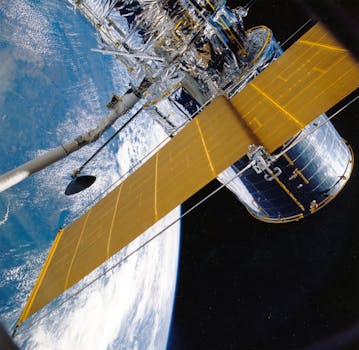The Future of Satellites: Revolutionizing Global Communication and Exploration

The Future of Satellites: Revolutionizing Global Communication and Exploration. The future of satellites holds great promise for revolutionizing global communication, exploration, and our understanding of the universe. With advancements in technology, satellites are becoming increasingly important for a wide range of applications, from navigation and communication to weather forecasting and scientific research.
Satellites have been a crucial part of modern technology for decades, providing a wide range of services that have transformed the way we live and work. However, the future of satellites is likely to be even more exciting, with new technologies and innovations emerging all the time. One of the most significant developments in the field of satellites is the emergence of small satellite technology. Small satellites, also known as CubeSats, are miniature satellites that are designed to be smaller, lighter, and more affordable than traditional satellites.
These small satellites are typically launched into low Earth orbit and are used for a variety of applications, including Earth observation, communication, and scientific research. They are often used in constellations, with multiple satellites working together to provide global coverage. The use of small satellites is revolutionizing the field of satellite technology, making it possible for more countries and organizations to access space and participate in the benefits of satellite technology.
Advancements in Satellite Technology
There have been many recent advancements in satellite technology, from improvements in propulsion systems to the development of new materials and technologies. One of the most significant advancements is the development of electric propulsion systems, which are more efficient and provide greater maneuverability than traditional chemical propulsion systems. This technology is being used in a variety of applications, including station-keeping and orbit-raising maneuvers.
Another significant advancement is the development of advanced materials and technologies, such as lightweight composites and 3D printing. These materials and technologies are being used to build lighter, stronger, and more efficient satellites, which can operate for longer periods of time and provide greater performance. The use of advanced materials and technologies is also reducing the cost of satellite production and launch, making it possible for more countries and organizations to access space.
The future of satellites is also likely to be shaped by the development of new launch technologies, such as reusable rockets. Reusable rockets are being developed by a number of companies, including SpaceX and Blue Origin, and are designed to reduce the cost of access to space. These rockets can be launched multiple times, reducing the cost of launch and making it possible for more satellites to be launched into orbit.
Applications of Satellites
Satellites have a wide range of applications, from navigation and communication to weather forecasting and scientific research. One of the most significant applications of satellites is in the field of navigation, where they are used to provide location information and timing signals. The Global Positioning System (GPS) is a network of satellites that provides location information and timing signals to GPS receivers on the ground.
Satellites are also used in the field of communication, where they are used to transmit data and voice signals around the world. They are often used in remote or underserved areas, where they provide the only means of communication. Satellites are also used in the field of weather forecasting, where they are used to monitor weather patterns and provide early warnings of severe weather events.
The use of satellites in scientific research is also becoming increasingly important, with satellites being used to study the Earth’s climate, the universe, and the effects of space weather on the Earth’s magnetic field. Satellites are also being used to search for exoplanets and to study the formation of galaxies.
Challenges and Opportunities
Despite the many advancements and applications of satellites, there are also a number of challenges and opportunities that must be addressed. One of the most significant challenges is the issue of space debris, which is becoming an increasingly significant problem in Earth’s orbit. Space debris is made up of old satellites, rocket parts, and other objects that are no longer in use and can cause collisions and damage to operational satellites.
Another significant challenge is the issue of satellite security, which is becoming an increasingly important concern in the age of cyber warfare. Satellites are vulnerable to cyber attacks, which can disrupt their operation and cause significant damage. The use of encryption and other security measures is becoming increasingly important to protect satellites from cyber threats.
Despite these challenges, the future of satellites holds great promise for revolutionizing global communication, exploration, and our understanding of the universe. With advancements in technology and innovations emerging all the time, the use of satellites is likely to continue to grow and expand into new areas.
Conclusion
In conclusion, the future of satellites is an exciting and rapidly evolving field, with new technologies and innovations emerging all the time. From small satellite technology to advancements in propulsion systems and materials, the use of satellites is becoming increasingly important for a wide range of applications. While there are challenges and opportunities that must be addressed, the future of satellites holds great promise for revolutionizing global communication, exploration, and our understanding of the universe.

